Microcement continues to set the standard for modern interior design, and bathrooms provide the perfect setting for the seamless surface coating to excel.
Forcrete specialises in providing industry-leading microcement for expert installers worldwide, and we know that it is the perfect product to create stunning bathroom aesthetics.
Interior designers and architects are already raving about microcement, but this page will explain the endless benefits of using microcement in your new bathroom design.
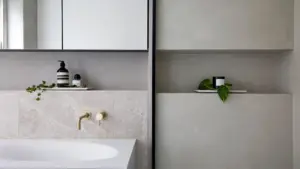
What is a microcement bathroom?
Microcement is a specialised decorative coating that has transformed property design – boasting versatility and elegant minimalism.
The material can be applied to almost any surface to produce an impressive seamless concept throughout your bathroom. Bathroom walls, showers, trays, bathtubs, sinks and furniture can all reap the benefits.
Microcement installations transform your bathroom or wet room into your private residential sanctuary.
Check out some examples of microcement bathroom installations from Forcrete experts.
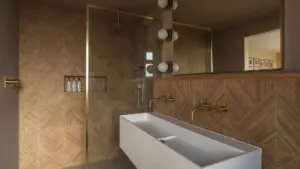
Is microcement good in a bathroom?
The water-resistant properties of microcement make it the ideal material for tackling the moisture and humidity associated with bathrooms and wet rooms. Microcement also has the bonus of no grout lines and is defiant against stains and mould – making it an easy surface to clean and maintain.
Forcrete offers the industry USP of being 100% waterproof before sealers.
Strength and durability are two other leading properties in the microcement toolkit. Microcement has resistance to cracks and abrasions – giving you the confidence it can withstand the demands of your bathroom environment for years to come.
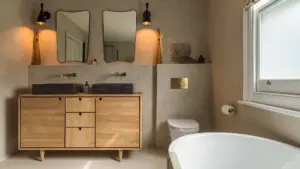
Most popular colours for microcement bathroom
Choosing the colour for your microcement project can be one of the trickiest parts of your installation. Everyone has their taste, but it’s important to consider lighting, your bathroom size and the mood you want to create.
Based on current trends, here are the four most popular colours for microcement bathrooms:
White: Classic white is a timeless colour choice for bathroom design. White creates a clean aesthetic and helps create the illusion of a bigger space while enhancing natural lighting.
Grey: The influence of grey tones is easily evident in contemporary bathroom design. Its neutrality offers sleek, modern surfaces that can pair with accent colours and materials.
Nude: Inviting nude tones add elegance and sophistication to your bathroom. The colour also helps to foster a warm and inviting atmosphere.
Charcoal/Black: Darker colours create bold, dramatic designs and striking contrasts. Architects use charcoals and darker tones to add luxury and depth to bathroom design – but it’s essential to balance with lighting to ensure the room does not become visually constricted.
Forcrete has a diverse colour range – from neutral classics to vibrant tones. Check out our online colour swatch here. We also provide sample boards in our standard range or bespoke colours to demonstrate the style of your bathroom installation. To make sure you get the colour you wan’t, we can even colour match to Farrow & Ball, Little Greene and many more.
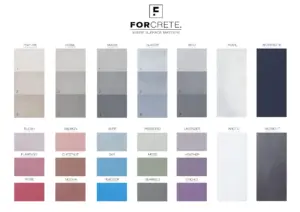
How long does it take to install microcement in a bathroom?
The time it takes to install a microcement bathroom can vary from one project to the next. Generally, a microcement installation usually ranges from two to seven days, but this depends on various factors:
- Size of the area
- Number of surfaces
- The complexity of the design
- Experience of the installers.
To ensure you receive an efficient and prompt installation in your bathroom, we recommend using a Forcrete expert. All Forcrete-approved installers handle every aspect of the project, from start to finish and guarantee you receive the bathroom you have dreamt of.
Find your microcement installer here today.
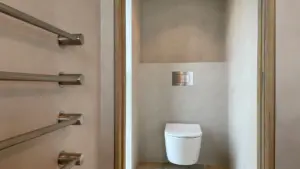
Ideas for applying microcement in bathrooms
The possibilities for using microcement in bathrooms are endless, but we have listed a few of our favourite ideas to enhance your space and achieve unique aesthetics:
Microcement walls: Bathroom walls coated in microcement create stunning, seamless and continuous surfaces – instantly modernising your space with minimalist beauty.
Microcement floors: Flooring often dominates bathroom spaces, and a microcement floor will transform your room to complement the overall design.
Shower enclosures: Microcement is an excellent choice for shower areas as it offers water resistance and eliminates the need for grout, reducing the risk of mould and mildew.
Vanity countertops: Upgrade your bathroom vanity by applying microcement to the countertop surface – creating a sleek and contemporary look while providing a durable and easy-to-clean surface.
Bathtubs: For a luxurious touch, consider microcement for the exterior of your bathtub to generate a stylish look and add a focal point to the bathroom.
Sinks: Custom-designed microcement sinks or basin countertops can be moulded and shaped to create bespoke sink designs.
Accents: Use microcement to add decorative accents in your bathroom, such as feature walls, niches, or shelving units. These accents can create visual interest and add depth to the space.
Remember to choose the appropriate colours and finishes that enhance your desired style – whether it’s a minimalist, industrial, or more vibrant design.
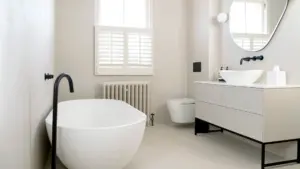
Can you microcement over shower trays?
Microcement shower trays are an attractive and hygienic alternative to plastic, and it is possible to install microcement directly over rigid shower trays. But this will depend on the surface strength and shower size. We recommend speaking to an industry expert before progressing with your installation.
Our friends at Resin Rock have created the perfect solution for a microcement-ready wet-room tray – becoming the first dedicated solution for creating a step-free and seamless microcement bathroom or wet room.
Their plastic-free trays have a highly textured pre-primed coating, which enables extreme bond strength for all microcements.
Can you microcement over tiles?
Yes, microcement can be applied directly over tiles thanks to the highly adhesive properties of the material. Microcement creates a new surface layer and provides a fresh look – without the need for building work or tile removal.
However, don’t forget about the below:
Surface preparation: Preparing your surface is crucial to guarantee successful application over bathroom tiles. Ensure you thoroughly clean all the tiles – removing all dirt, grease and loose grout. We also recommend using a primer to improve adhesion.
Tile condition: You may need to repair or replace damaged tiles to secure a smooth, even microcement finish.
Thickness consideration: Microcement is a thin coating, typically applied in multiple layers ranging from two to three millimetres. Please consider the thickness of the microcement layers when calculating the space between tiles and adjacent surfaces, such as doors or cabinets, to ensure proper clearance.
